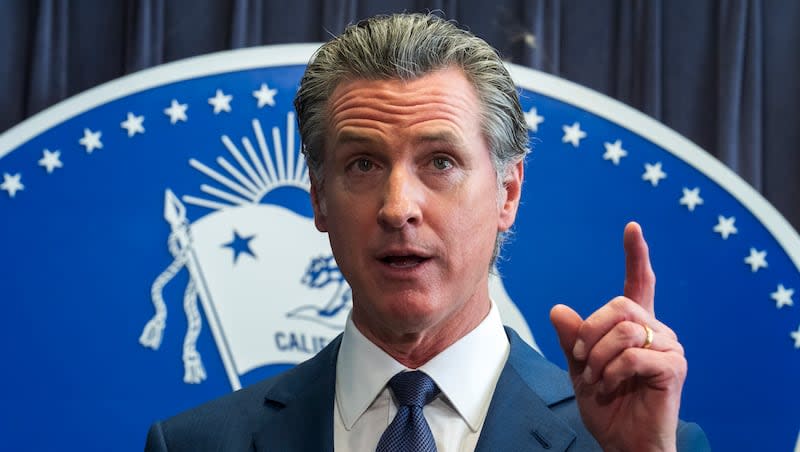Are tax hikes the solution to California’s $73 billion budget deficit?

- Oops!Something went wrong.Please try again later.
California’s money problems are reaching new heights — with no concrete solution in sight.
Back in January, Gov. Gavin Newsom estimated his state would face a $37.9 billion deficit in fiscal year 2024-2025, despite the Legislative Analyst’s Office predicting a much higher shortfall of $68 billion.
Turns out, both Newsom and the Legislative Analyst’s Office were off track. The Golden State’s money pit is expected to be $73 billion or higher, according to the latest update.
Legislative analysts say the deficit problem has ballooned since their last estimates at the beginning of the year. The reason? The data shows the state collected $24 billion less than anticipated in revenue, which translates to a $15 billion increase in the deficit.
California doesn’t have a plan ... yet
Newsom and state lawmakers say they are working together to find solutions.
In a statement, the governor said, “Despite the uncertainty due to the federal tax deadline delay last year, historic reserves and fiscal responsibility will assure a balanced budget that meets California’s needs.” But apart from planning on a range of $12 billion to $18 billion in cuts, the state hasn’t released a plan.
California Assembly Speaker Robert Rivas, a Democrat, said the Assembly will continue working on an agreement and plans to hold “more than two dozen budget and oversight hearings in the next month,” indicating there could be steep cuts to state programs.
“There are tough choices on the horizon, which is why our process is so critical,” he said.
The “Shrink the Shortfall” budget plan, introduced on March 14, proposes dipping into California’s rainy day fund to cover $12.2 billion. Other solutions include deferring $2.1 billion in spending, delaying $3.2 billion, slashing $3.4 billion from programs and shifting $3.9 billion in funds. It also recommends borrowing money or increasing taxes by $3.6 billion.
But state Sen. Scott Weiner, a Democrat who chairs the state’s Budget and Fiscal Review Committee, who proposed the “Shrink the Shortfall” plan, said, “Tax increases are not the easiest thing in the world,” according to ABC News.
“In Sacramento, it requires a two-thirds vote, and I’m not optimistic that we will see tax increases this year to help reduce the deficit,” said Weiner.
The Newsom administration is sticking to its initial hopeful projects of a nearly $38 billion shortfall. H.D. Palmer, the deputy director of California’s Department of Finance and Newsom’s spokesperson, told Fox News that they hope to see more revenue than projected come in before taxes are due.
“A responsible step would be for the Legislature to act now on the early action budget measures needed for $8 billion in solutions to help close this gap,” Palmer said.
Expired pandemic-era funding and tax breaks
California isn’t the only state struggling to balance its budget in the absence of expired federal pandemic aid. According to Stateline’s analysis of U.S. Census Bureau estimates, state revenue was down by 4% last year, with California and New York seeing the biggest losses of $56 billion out of the total $66 billion.
The American Rescue Plan provided $350 billion in funding to states, as well as local territorial and tribal governments during the COVID-19 emergency.
As federal pandemic aid filled up state coffers, 26 states decided to lower either personal or corporate income tax rates, or both, between 2021 and 2023, which is expected to result in estimated lost revenue of $11 billion over the next five years, the Center on Budget and Policy Priorities noted.
States across the U.S. introduced other tax breaks, like one-time rebates or senior tax breaks, during the pandemic, according to the Tax Policy Center. Utah, too, decreased individual and corporate state income tax rates in the latest legislative session, bringing the rate down from 4.65% to 4.55%. This adds up to roughly $170 million in reduced revenue, as the Deseret News previously reported. This is despite Utah’s revenue falling short by $50 million during fiscal year 2023 because of “lower than expected income tax collections.”
Arizona and Colorado also cut taxes, indicating a pattern where Mountain West states are offering relief to taxpayers, while coastal states, like New York and California, are opting for tax hikes in order to balance their overextended budgets, as Jared Walczak, vice president of state projects at The Tax Foundation, pointed out.
Plus, concerns over a recession haven’t died down, even though the economy continues to remain stable. “But at some point, perhaps soon, the economy will turn, and states that passed bigger, permanent tax cuts will face tougher fiscal choices because of those tax cuts,” wrote Tax Policy Center’s Richard C. Auxier.
He added, “If and when that happens, they should remember what taxes they cut, and who they benefited, in that new budget environment.”

